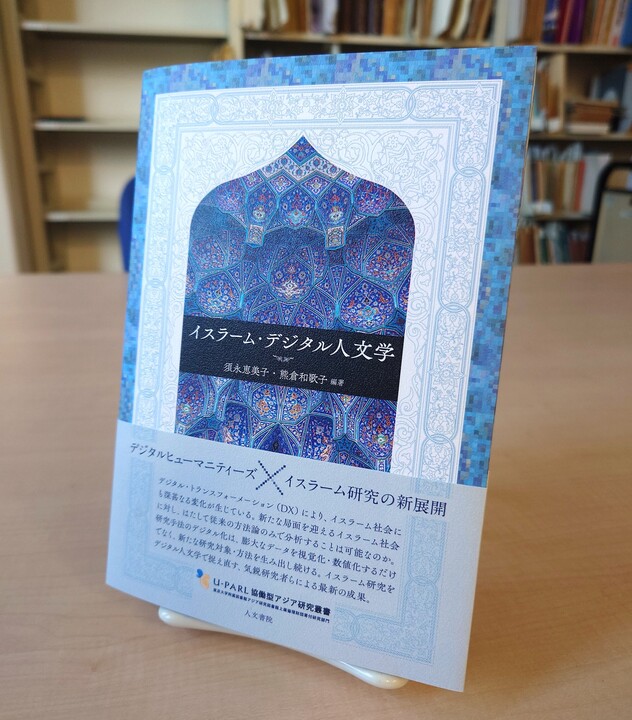In February 2024, Digital Islamicate Studies was published by Jimbun Shoin presenting results of Towards Cooperative Research in Asian Studies: Research Project 5 “Research on Digitization of Research Materials in South Asia,” for which project research fellow Emiko SUNAGA serves as research leader.
Dr. SUNAGA was in charge of writing Chapters 1 and 4, Column 9, and Bibliography. From U-PARL, Project Assistant Professor Yasuhiro TOKUHARA also wrote a Column. Professor Wakako KUMAKURA, co-editor, is one of the U-PARL’s founding members.
Digital Islamicate Studies 『デジタル・イスラーム人文学』
Feb 2024, Jimbun Shoin
ISBN: 9784409420256
***
New Developments in Digital Humanities × Islamic Studies
Digital transformation (DX) has been causing profound changes in Islamic society just like in any other part of the world. Is it still possible to analyze Islamic society, which is about to enter a new phase, only by applying conventional methodology? Digitization of research methods does not only allow for visualisation and quantification of enormous amounts of data, but also continues to produce new study subjects and methods. Take a look at the latest findings by up-and-coming researchers trying to redefine Islamic studies through the Digital Humanities approach. (From obi-strip)
***
The Islamic community, which is estimated to account for roughly one-fourth of the current world population, is neither archaic, nor isolated from the rest of the world. A bakery employee in Egypt or a student of some regional university in Iran both own smartphones and use SNS or video calls to communicate with family or friends. Just like Japan, Islamic local communities are rapidly changing in the modern time of thriving AI (artificial intelligence), big data, and IoT (Internet of things) technologies on the wave of ever progressing DX (digital transformation). (From Chapter 1)
***

CONTENTS
Chapter 1. Introduction to Digital Islamicate Studies by Emiko SUNAGA
Column 1. Digitization of Afghanistan-related Materials: Possibility of Using Research Materials in Conflict-Torn Region by Masato TORIYA
Chapter 2. Digitized Sacred Books: Sounds and Characters of Quran and Hadith by Toshiyuki TAKEDA
Column 2. Online Sermons: Islam in the Age of YouTube and Instagram by Ayaka KURODA
Chapter 3. Opening Closed Texts to the World: Digital Humanities and Textual Research on Islamic Law by Yuki SHIOZAKI
Column 3. Unicode and Arabic Alphabet: Mechanism to Connect Letters Globally by Yasuhiro TOKUHARA
Chapter 4. Automatic Character Recognition and Text Conversion: Automatic OCR of Urdu by Transkribus by Emiko SUNAGA
Column 4. Digitization of Rare Handwritten Fonts: OCR of Arabic Language Manuscript in Maghrebi Script Using Transkribus by Yukari TANAHASHI
Chapter 5. Quantitative Text Analysis: Method for Quantitative Analysis of Text Data by Dai YAMAO
Column 5. Distant Reading of Historical Sources in Arabic: Attempting Analysis of Al Muqaddimah (Introduction to History) using Voyant Tools by Yuta ARAI
Chapter 6. TEI Guideline and OpenITI mARkdown: History Research and Analysis Employing Markup Method by Wakako KUMAKURA
Column 6. RDF: Digitizing Fragmented Historical Knowledge by Erina OTA (TSUKADA)
Chapter 7. Visualizing Networks: Case Study on Biographic Historical Sources from Early Modern Maghrib by Tomoaki SHINODA
Column 7. History of Ottoman Empire and Digital Humanities: MapOE, Koç University, University of Vienna by Sayuri KAWAI
Chapter 8. Digitization of Staves: Case Study on Quran, Surah 1, Ayah 2 by Yuri ISHIDA
Column 8. Social Media and Islam: Understanding Practices Employing New Media by Tatsuro FUTATSUYAMA
Chapter 9. Measuring Human Activities by Artificial Satellites: Analyzing Ramadan Through Nighttime Light Images by Shun WATANABE
Column 9. IIIF: Comparing and Accessing Digital Materials Throughout the World by Emiko SUNAGA
Bibliography: Research Projects Dealing with Digital Materials from Muslim World. Physical Archives. Digital Archives by Emiko SUNAGA
AFTERWORD
INDEX
*The above titles has been translated into English by the editors. New translations may be published by the authors of the chapters.
March 4, 2024

